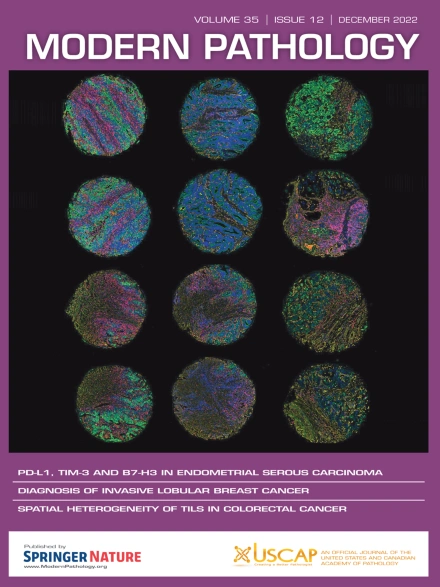体细胞源性“卵黄囊瘤”的表型和分子特征:与生殖细胞源性肿瘤的异同。
IF 5.5
1区 医学
Q1 PATHOLOGY
引用次数: 0
摘要
一部分体细胞癌在形态和免疫表型上与生殖细胞起源的卵黄囊瘤(YST)相似,包括胎儿肺腺癌(FLACs)和具有YST /肠母细胞分化的体细胞癌。至少这些肿瘤中的一些可能是由体细胞重编程引起的,导致获得“多能”表型。尽管这些体细胞肿瘤表达SALL4、glypican 3和AFP等标记物,这些标记物在生殖细胞源性YST中呈阳性,但目前尚不清楚它们的分子特征与生殖细胞肿瘤(gct)的分子特征有多大程度的重叠。我们评估了i(12p)(荧光原位杂交)和microRNA-371 ~ 373(实时定量PCR)水平,这是gcnis衍生的gct的标志,在11个具有YST/肠母细胞表型的体源性肿瘤(以下称为“YST样”肿瘤)队列中。此外,我们使用免疫组织化学评估FOXA2的表达,FOXA2是gct中诱导和维持YST表型的关键调节因子。所有(n = 11) yst样肿瘤均表达FOXA2, i阴性(12p)。miR-371a-3p (miR-371 ~ 373簇中最特异性的成员)的表达在6/10(60%)的yst样肿瘤中可检测到。四个样本的水平处于检测的灰色地带(即临床意义不确定的表达),两个样本(来自单个患者的不同肿瘤)的阳性水平与非畸胎瘤gcnis衍生的gct相似。microRNA集群的其余成员(miRs 372和373)遵循相同的模式。我们的研究结果表明,体源性YST样肿瘤和生殖细胞源性YST的重叠超越了形态学,包括YST表型的主要调节因子之一的表达,在某些情况下,miR-371a-3p的表达。然而,这些肿瘤缺乏gcnis衍生的gct的标志性发现[i(12p)],并且与gct表现出显著的生物学和临床差异。本文章由计算机程序翻译,如有差异,请以英文原文为准。
Phenotypic and Molecular Features of Somatically Derived “Yolk Sac Tumors”: Similarities and Differences With Counterparts of Germ Cell Origin
A subset of somatic carcinomas shows morphologic and immunophenotypic similarities to yolk sac tumor (YST) of germ cell origin, including fetal adenocarcinomas of the lung and somatic carcinomas with “YST”/enteroblastic differentiation. At least some of these tumors may result from reprogramming somatic cancer cells, leading to the acquisition of a “pluripotent” phenotype. Although these somatic tumors express markers such as SALL4, glypican 3, and alpha-fetoprotein, which are positive in germ cell-derived YST, it is currently uncertain to what degree their molecular features overlap with those of germ cell tumors (GCTs). We assessed i(12p) (fluorescence in situ hybridization) and levels of micro-RNA-371-373 (real-time PCR), hallmarks of germ cell neoplasia in situ (GCNIS)-derived GCTs, in a cohort of 11 somatically derived neoplasms with YST/enteroblastic phenotype (designated as “YST-like” tumors hereafter). In addition, we used immunohistochemistry to assess expression of FOXA2, a critical regulator of induction and maintenance of YST phenotype in GCTs. All YST-like tumors showed expression of FOXA2 and were negative for i(12p). Expression of miR-371a-3p (the most specific member of the miR-371-373 cluster) was detectable in 6 of 10 (60%) of YST-like tumors. Four samples showed levels in the gray zone of detection (ie, expression of uncertain clinical significance), and 2 samples (separate tumors from a single patient) showed positive levels similar to those found in nonteratoma GCNIS-derived GCTs. The remaining members of the micro-RNA cluster (miRs 372 and 373) followed the same patterns. Our results show that the overlap of somatically derived YST-like tumors and YSTs of germ cell origin goes beyond morphology, including expression of one of the master regulators of the YST phenotype and, in some cases, miR-371a-3p. However, these neoplasms lack a hallmark finding of GCNIS-derived GCTs (i[12p]) and show significant biologic and clinical differences with GCTs.
求助全文
通过发布文献求助,成功后即可免费获取论文全文。
去求助
来源期刊

Modern Pathology
医学-病理学
CiteScore
14.30
自引率
2.70%
发文量
174
审稿时长
18 days
期刊介绍:
Modern Pathology, an international journal under the ownership of The United States & Canadian Academy of Pathology (USCAP), serves as an authoritative platform for publishing top-tier clinical and translational research studies in pathology.
Original manuscripts are the primary focus of Modern Pathology, complemented by impactful editorials, reviews, and practice guidelines covering all facets of precision diagnostics in human pathology. The journal's scope includes advancements in molecular diagnostics and genomic classifications of diseases, breakthroughs in immune-oncology, computational science, applied bioinformatics, and digital pathology.
 求助内容:
求助内容: 应助结果提醒方式:
应助结果提醒方式:


